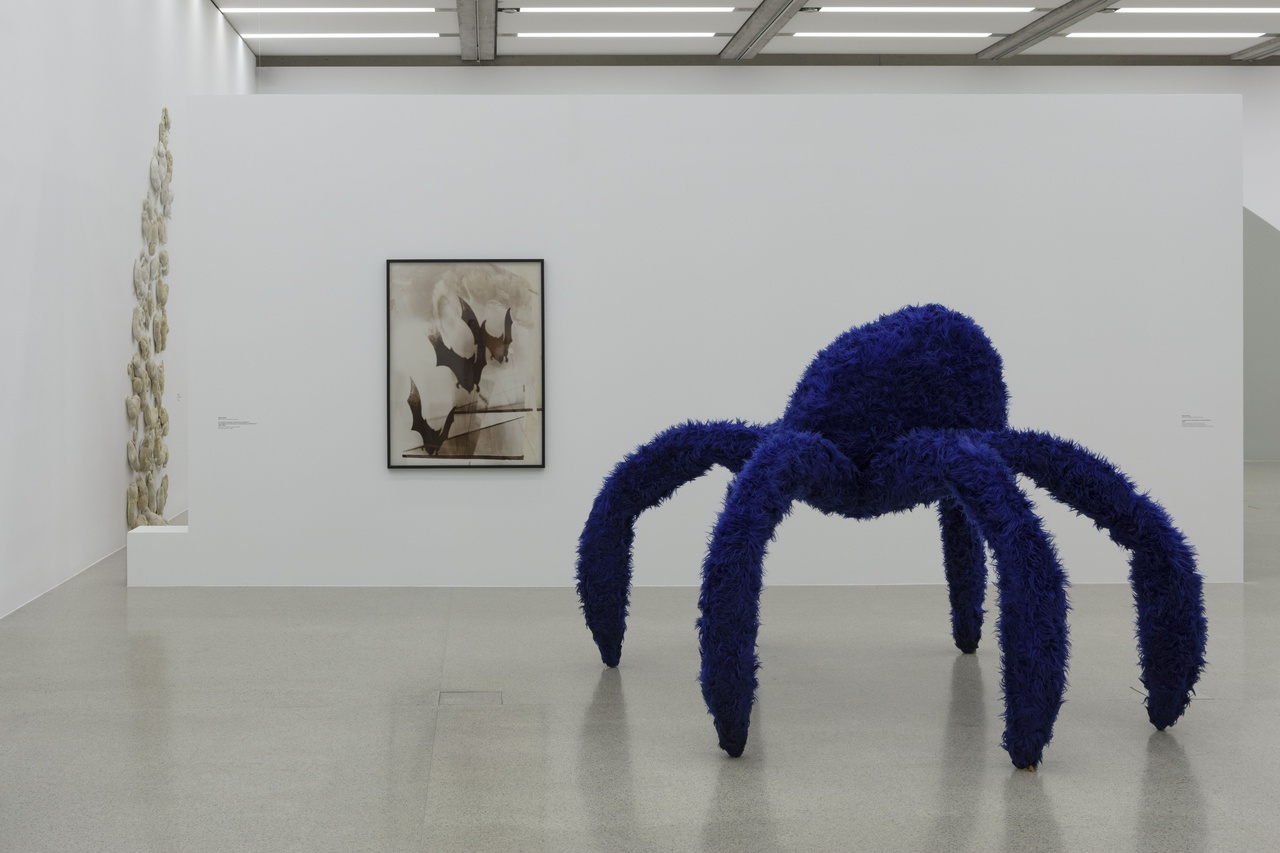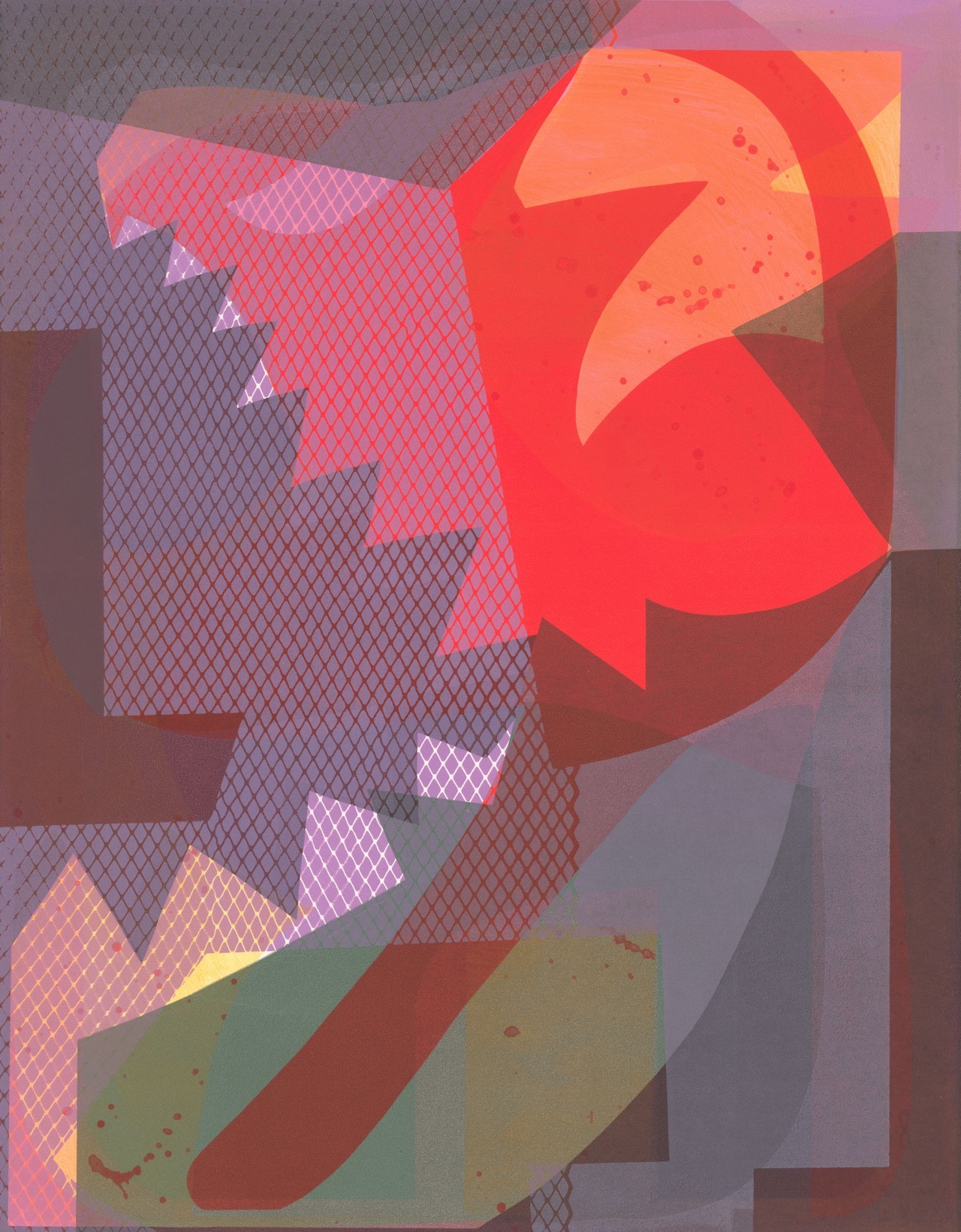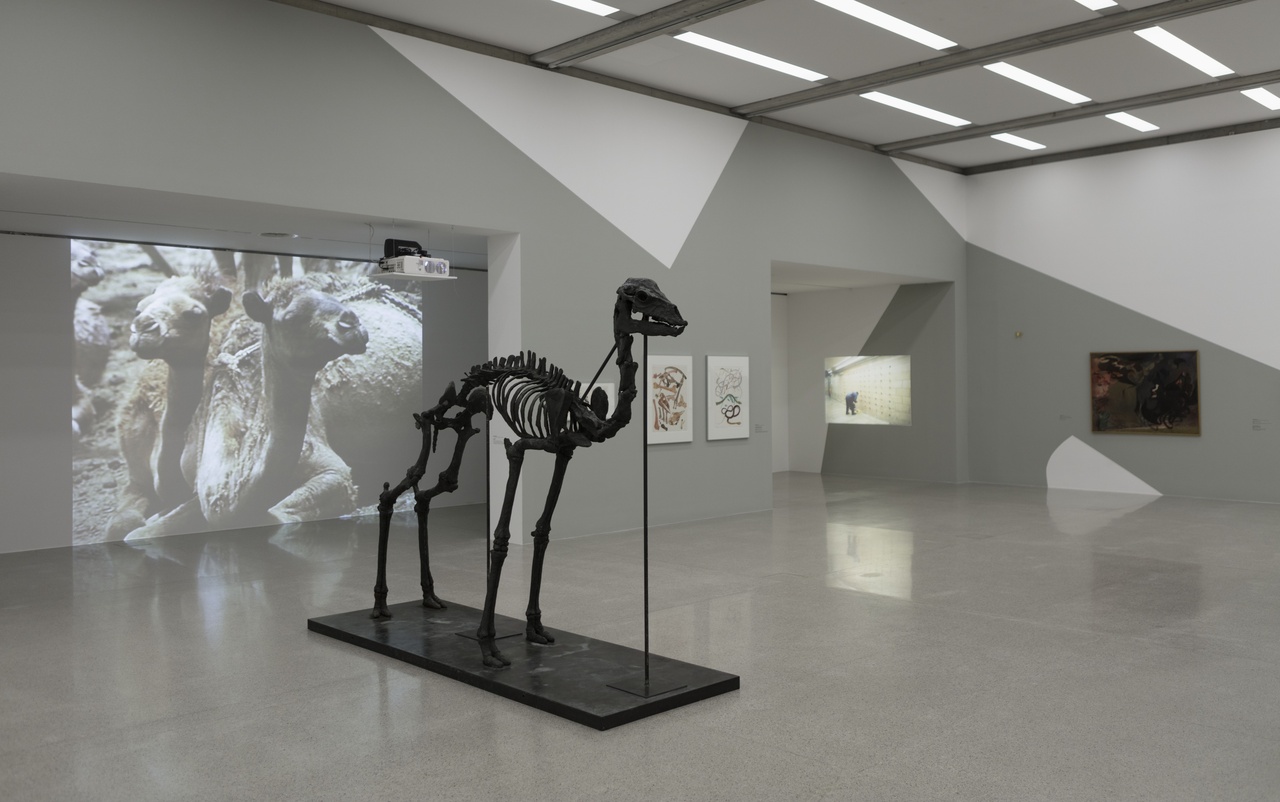TIERING THE CANON Fiona McGovern on “The Animal Within” at mumok, Vienna

„Das Tier in Dir – Kreaturen in (und außerhalb) der mumok Sammlung“, mumok, Wien, 2022–23, Ausstellungsansicht / installation view
“What kind of zoo is the museum?” The question, emblazoned on the glass wall facing the mumok’s lobby, is the opening gambit of the exhibition “The Animal Within: Creatures in (and outside) the mumok Collection.” Of the altogether eight questions raised, in German and English, at various junctures in the presentation, it is the only one that directly addresses the museum and, with it, the visitors who roam its galleries. It is also the only one for which the curators chose a literal translation into English. The other questions mostly allude to idioms in which animals figure: expressions that serve to articulate power relations, instances of injustice, and courses of action that are (potentially) doomed to fail. To quote only four: Wer sichert sich den Löwenanteil? Who puts a bug in whose ear? Wer lebt wie die Made im Speck? Who is flogging a dead horse? In this way, the opening question hints at a self-reflective dimension of the project – which resurfaces here and there throughout the show –framing the relationship between humans and animals in a variety of perspectives and so at once also undertaking a critical interrogation of the museum as an institution whose work of collecting cannot be conceived in isolation from social and political events and circumstances. The animal, then, is not only a motif in and material of the art on display – mercifully, no live specimens were included – but also the vehicle for a deliberate intervention into the canon of art history with its conventional processes of categorization and attendant curatorial decisions.
Organized by mumok curator Manuela Ammer and the New York–based artist Ulrike Müller, the exhibition and the extensive research in the museum’s database that went into it were occasioned by the institution’s 60th anniversary. The curators were surprised, as they confess in an interview in the museum’s magazine, to find that around 500 works in the collection, or roughly 5 percent of the total holdings, feature animal motifs or are in some material way connected to animals. [1] Moreover, “The Animal Within” resumes a curatorial collaboration between Ammer and Müller that began with “Always, Always, Others: Non-Classical Forays into Modernism,” a presentation of art from the mumok’s collection that was on view in the winter of 2015–16. That display was flanked by a solo exhibition in which Müller showed small abstract enamel pieces as well as several large-format carpets with similarly abstracted cat motifs. One of those carpets now acts as a kind of visual hinge connecting the earlier exhibition to the new one; so does Alfred Klinkan’s striking bird painting Gelber Schamane (Yellow Shaman, 1977–78), on view here in combination with his Schnittmusterbogen (weißer Vogel mit spitzem Schnabel) (Pattern Sheet [White Bird with Pointed Beak], 1977), on loan from the Albertina in Vienna.

Ulrike Müller, „Cat Music“, 2021
Taking up three exhibition floors, the presentation is divided into three thematic fields: On the ground floor, the introduction, dedicated to humans’ ambivalent relationships with their “domestic animals,” is structured like a bourgeois apartment. Right by the entrance, visitors encounter Pino Pascali’s oversized blue plush spider La vedova blu (The Blue Widow, 1965), which straddles the poles of domestication and phobia and is flagrantly at odds with long-accepted ideas about Arte Povera. Gina Pane has maggots crawl over her face in the video Action Death Control (1975), while the protagonists of Chéri Samba’s painting Lutte contre les moustiques (Battle against the Mosquitoes, 2000) hunt the titular insects. Next are works that take on the human consumption of meat, including Carolee Schneemann’s performance film Meat Joy (1964) as well as Madame D’Ora’s investigation of the industry behind it in black-and-white shots from the series Schlachthäuser in Paris (Slaughterhouses in Paris), which the artist, previously known primarily for her fashion and portrait photography, began in 1948. Subsequent sections delve into the “animal” aspects of sexuality and of (fascist) education; the latter are rendered to especially haunting effect in Werner Büttner’s painting Kaspar Hauser–Enten folgen einer Attrappe (Kaspar Hauser Ducks Following a Dummy, 1981), which alludes to the behavioral scientist Konrad Lorenz’s experiments. [2] The adjoining “child’s room” exposes the racist undercurrents in toys in the example of a so-called snare picture – or, in this instance, snare construction – by Daniel Spoerri, Der Kinderkäfig von Nathalie (The Children’s Cage of Nathalie, 1969), which shares the space with Ull Hohn’s paintings Untitled (Infant, 1991) and directly confronts the multimedia Porträt-Landschaft H.H. (Helga Hahn mit Tochter Nathalie) (Portrait Landscape H.H. [Helga Hahn with Daughter Nathalie], 1971) by Ursula (Schultze-Bluhm).
The presentations on the other two gallery floors, headlined “Borrowed Plumes” and “Nature Morte,” respectively, venture outside the domestic sphere narrowly conceived to explore animal metaphors and symbolism, exoticisms and gender stereotypes, the relation between life and death, the materiality of animal bodies and furs, but also the idealization and anthropomorphism of animals. In Gülsün Karamustafa’s video The City and the Secret Panther Fashion (2007), for one, a group of girlfriends gather in a private home for an exercise in self-empowerment, dressing in predator animal prints from head to toe, before heading back out in their everyday wear. The Pop artist Jann Haworth, whose Snake Lady (1969–71) is a recent accession to the museum’s collection, was often upstaged by her male colleagues. The cover of the Beatles album Sgt. Pepper’s Lonely Hearts Club Band, for example, was co-created with her husband Peter Blake, while her soft sculptures never became as famous as Claes Oldenburg’s. Dušan Makavejev’s experimental film Nova domaća životinja (New Domestic Animal, 1964) registers the impact of industrialization on animal husbandry and agriculture; Kurt Talos’s photographic series Niederösterreichers Kolonisierung (Lower Austrian’s Colonization, 1971) interrogates the idea of the homeland from an unwonted angle, while Wifredo Lam pays homage to a priestess of the Santería religion in Elegua (1959), painting her with a horse’s head in reference to her divine power.
Even this small selection from the works on view illustrates the sometimes positively eclectic mix of contexts of origin, materialities, and visual idioms, of familiar and canonized works as well as ones that, long overlooked by (German-speaking) art historians, have remained largely obscure. “The Animal Within” does not present a “best-of,” as one might expect in an anniversary exhibition, nor does it simply unearth “forgotten” or neglected positions in the collection. Rather, it unfurls a wide-ranging panorama of works and creative engagements without shoehorning them into too tightly defined categories, enabling the audience to draw a multiplicity of connections – to questions that have sparked growing debates in recent years under watchwords like animal turn and Anthropocene, postcolonialism, critical posthumanism, and ecofeminism. Purposely avoiding direct references to contemporary discursive trends and offering little by way of explication, the exhibition instead emphasizes implicit narratives, whose different strands visitors must unravel for themselves, with assistance, if they wish, from the museum’s art education team in the form of guided tours, entries in the museum’s blog, the interview with the curators mentioned above, or the publication accompanying the show.
Another element that weaves the exhibits together is a mural by Müller that extends through all the galleries. Like large shadows, abstract forms in varying shades of gray sprawl over the white museum walls; some of the latter, for that matter, have been tipped over and laid flat on the floor, opening visual axes and serving as seating furniture immanent to the display. In this way, the mural gestures toward a superordinate dimension, a realm beyond human perception, as well as toward the museum as such. The visitors are reminded again and again of their own physical presence in the exhibition – and hence of the implicit rules and internalized patterns that govern their behavior.
In the “book of pictures and stories” released in conjunction with the exhibition, Ammer and Müller drily note that the show might in principle have been mounted by any of the museum’s peer institutions all over the Western world. [3] Obvious ecological and economic considerations aside, this observation led them to limit the selection of loans, which make up roughly a quarter of the near 400 works on display, to pieces from Austrian and Italian collections. In this sense, “The Animal Within” can be read in more than one way as a critical examination of how museums use their collections. Still, the exhibition steers clear of any overly didactic mode. For example, there are no warning labels placed in the rooms (even where one might expect to see them) or critical remarks about discrimination, although the accompanying essays and guided tours indicate that such concerns are very much on the curators’ minds. “The Animal Within” thus provides fairly candid insight into the more complicated and problematic aspects of museums’ collections, banking on the cogency of visual constellations and trusting visitors’ own judgment. In that sense, the show also raises the question of whether such advisories and self-critical contextualizations might not more fitly appear outside individual exhibitions, cautioning visitors about the collection as a whole and museums as such.

„Das Tier in Dir – Kreaturen in (und außerhalb) der mumok Sammlung“, mumok, Wien, 2022–23, Ausstellungsansicht / installation view
The accompanying booklet, in the style and square format of an illustrated children’s book, is available for free on all three gallery floors. The texts in it were written by Jörg Wolfert, curator of art education at the museum: an intentional departure from the usual curatorial essay. In the abovementioned publication, which resolutely breaks with the conventions of the exhibition catalogue genre, Ammer and Müller have titled their own contribution “In Place of an Introduction.” It is not interpretational control they are after but a reconstruction of the inner logic of their emphatically “exemplary undertaking,” [4] which they begin rather head-on with a discussion of the pitfalls of Spoerri’s snare picture. The illustrations in the book show greatly enlarged details from individual exhibits rather than the works in their entirety. Short explanatory notes are dedicated to a judicious selection of works. The other essays, commissioned from Fahim Amir, Jack Halberstam, Johanna Hedva, Kerstin Stakemeier, Oxana Timofeeva, and others, are more loosely connected to the exhibition and written in a less constrained and more essayistic style. A complete inventory of the works in the exhibition, with technical information and thumbnail-size reproductions, has been relegated to an appendix.
“The Animal Within” does things differently in many ways, without obviously borrowing from the strategies of critical collection presentations held in recent months and years. One may detect echoes of last year’s exhibition “Heute Nacht geträumt” by Ruth Buchanan at the Kunstmuseum Basel | Gegenwart, for which the artist had sifted through the museum’s collection based on a predefined scoring system; questions in English and German on each gallery floor addressed the relevance museums have today. Müller, in the interview for mumok’s magazine, emphasizes that the significance of her contribution as an artist should not be overstated, as she and Ammer pursued similar interests. In fact, though, her outsider’s position, like Buchanan’s, was crucial to making the exhibition in its present form possible. It is a show that eschews overly definitive claims and instead opens up spaces for seeing and thinking; it aspires to broad public appeal and accessibility while being exceptionally multifaceted on the conceptual level.
The largest of the presentations currently on view at the mumok, “The Animal Within” is also a key contribution to a polyphony of different positions and perspectives on the collection and the museum’s (future) orientation: on the basement level, Naoko Kaltschmidt has curated an exhibition of new accessions to the collection under the programmatic title “Changes” that is anchored by the recently deceased artist Sam Gilliam’s floating Change. In “mixed up with others before we even begin,” on the upper floors, Franz Thalmair and artists invited for the occasion initiate a dialogue between the museum’s own collection and that of the local natural history museum. Between them, the Slovakian-born Romani Emília Rigová’s solo show “Nane Oda Lavutaris/Who Will Play for Me?” probes the tensions between self-image and heteronomy in a participatory installation of pianos and plants. What kind of zoo is the museum? That will remain an intriguing question well after these exhibitions close.
“The Animal Within. Creatures in (and outside) the mumok Collection,” mumok, Vienna, September 22, 2022–February 26, 2023.
Fiona McGovern is an art historian, author, and curator. She is professor for Curatorial Practice and Art Mediation at Universität Hildesheim.
Image credit: 1 + 3: photo © mumok / Stephan Wyckoff; 2: Courtesy of the artist and Galerie Meyer Kainer
Notes
| [1] | “What Kind of Zoo Is the Museum?,” interview with Manuela Ammer and Ulrike Müller, mumok Magazine, September 2022, 11. |
| [2] | Konrad Lorenz applied for membership in the Nazi Party in June 1938 and soon became an associate of its Office of Racial Policy. He warned of what on one occasion he called the transformation of man into a “domestic pig.” Shortly after the end of the Second World War, a position was created for him at the Max Planck Institute for Behavioral Physiology; he became its director in 1961. In 1973, Lorenz was awarded the Nobel Prize for his research. |
| [3] | Manuela Ammer and Ulrike Müller, “In Place of an Introduction,” in The Animal Within: Creatures in (and outside) the mumok Collection, ed. Manuela Ammer and Ulrike Müller (Cologne: Verlag der Buchhandlung Walther und Franz König, 2022), 15. |
| [4] | Ibid. |
